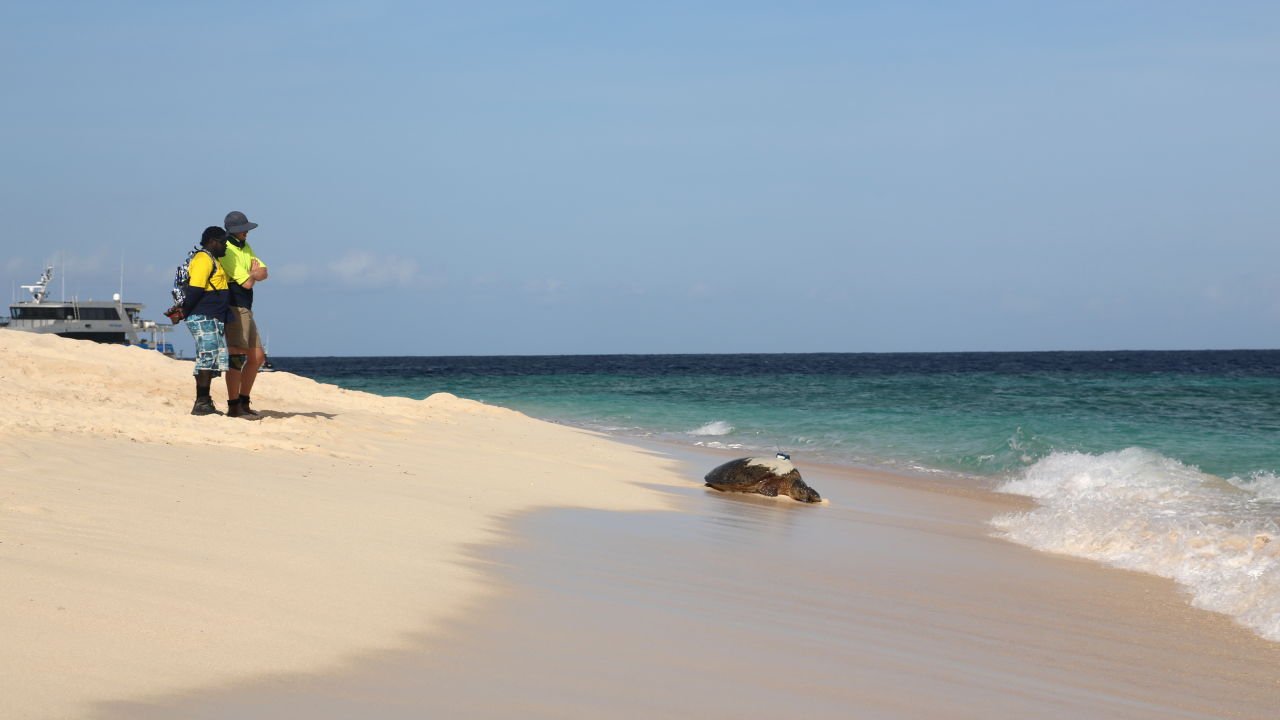Media Release ·
Trackers reveal the secret lives of Raine Island’s turtles

Researchers
are currently trawling through a wealth of data that has come from 19 green
turtles that were tagged last year with satellite tracking devices as part of
the collaborative Raine Island Recovery Project with the Palaszczuk Government.
The Recovery Project is a five-year, $7.95 million collaboration between the Government, Great Barrier Reef Marine Park Authority, Wuthathi and Kemer Kemer Meriam Nation (Ugar, Mer, Erub) Traditional Owners, BHP and the Great Barrier Reef Foundation, and aims to protect and restore Raine Island’s critical habitat.
Environment Minister Leeanne Enoch said turtles were tagged in November 2017 as part of the Queensland Government’s ongoing efforts to protect and study the ecology of Raine Island; a vital nesting site on the northern tip of Australia’s Great Barrier Reef.
“The tracking is a collaborative research effort between JCU and the Department of Environment and Science,” Ms Enoch said.
“JCU is analysing the data from the 19 green turtle since the beginning of the current nesting season and researchers will continue their analysis as the turtles return to their foraging grounds.
“The information will go a long way to help underpin the management of Raine Island, in particular to help us develop interventions for viable nesting beaches and to improve the rate of nesting of these beautiful creatures.”
Associate Professor and senior lecturer at JCU Mark Hamann said he found it fascinating to receive the tracking data on a daily basis and see glimpses into the otherwise secret lives of the marine turtles.
“Trying to predict what the turtles are going to do next is exciting – these turtles just keep teaching us new things,” A/Prof Hamann said.
“We have had turtles sit close to the island and hardly move for three months, and yet others have, unexpectedly, done long week long trips of up to 100km away and then travelled back to Raine.
“It is an incredible project to be involved with and see first-hand how science, government and traditional owners can come together to design and implement a project that will substantially increase our understanding of turtle biology and our ability to mitigate threats.”
The Raine Island Recovery Project is now in its third year and has included the construction of fences to prevent turtles falling from cliffs, as well as the re-profiling of sections of nesting beach to prevent tidal inundation.
Raine Island sits more than 600km off the coast of Cairns and is not accessible by the public.
Minister Enoch said the Raine Island Recovery Project was a unique attempt to intervene in natural processes and maintain this significant rookery for future generations of green turtles.
“Many of the management actions being taken on Raine Island, especially the re-profiling of sections of beach, have never been tried before on such a scale or in such a remote location,” Ms Enoch said.
“That’s why it’s so important to obtain as much data as possible and analyse it, so that we can ensure this work is making a positive difference to the conservation of green turtles.”
Minister Enoch said the continuous monitoring throughout the nesting season would help researchers evaluate the turtle nesting success on the re-profiled sections of beach relative to the remaining unmodified areas on the island.
“The satellite telemetry project is investigating the behaviour of the breeding females, how frequently they come ashore to nest, how often they lay and which parts of the island habitat they are frequenting,” Ms Enoch said.
“The project will also add to our understanding of where the turtles go once they leave Raine Island at the end of the nesting season and the route they take on their long journey back to their foraging grounds.”
BHP Billiton Mitsubishi Alliance (BMA) Asset President Rag Udd said the plight of the internationally endangered green turtle is of great interest to people both in Australia and worldwide.
“The Raine Island Recovery Project is an exciting example of business, governments, Traditional Owners and not for profits working together to protect the Great Barrier Reef, in this case the remarkable ecosystem of Raine Island,” Mr Udd said.
“Sharing the research data and results of the turtle movements, we know will not only have a positive impact on the future sustainability of Raine Island and its marine residents, but it will also inspire others to take an active role in helping to protect these magnificent and endangered animals.”




